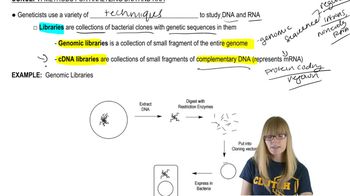A total of 20 men and 20 women volunteer to participate in a statistics project. The height and weight of each subject are given in the table. Draw one histogram for the height of the subjects and a separate histogram for weight. Use different colors for men and women so that you can visually compare the distributions by sex and plot weights in 10-lb intervals (i.e., 90–99 lb, 100–109 lb, 110–119 lb, etc.).
Table of contents
- 1. Introduction to Genetics51m
- 2. Mendel's Laws of Inheritance3h 37m
- 3. Extensions to Mendelian Inheritance2h 41m
- 4. Genetic Mapping and Linkage2h 28m
- 5. Genetics of Bacteria and Viruses1h 21m
- 6. Chromosomal Variation1h 48m
- 7. DNA and Chromosome Structure56m
- 8. DNA Replication1h 10m
- 9. Mitosis and Meiosis1h 34m
- 10. Transcription1h 0m
- 11. Translation58m
- 12. Gene Regulation in Prokaryotes1h 19m
- 13. Gene Regulation in Eukaryotes44m
- 14. Genetic Control of Development44m
- 15. Genomes and Genomics1h 50m
- 16. Transposable Elements47m
- 17. Mutation, Repair, and Recombination1h 6m
- 18. Molecular Genetic Tools19m
- 19. Cancer Genetics29m
- 20. Quantitative Genetics1h 26m
- 21. Population Genetics50m
- 22. Evolutionary Genetics29m
20. Quantitative Genetics
Analyzing Trait Variance
Problem 1d
Textbook Question
How do we assess environmental factors to determine if they impact the phenotype of a quantitatively inherited trait?
 Verified step by step guidance
Verified step by step guidance1
Identify the quantitative trait of interest and measure its phenotype across a population exposed to different environmental conditions.
Collect data on environmental variables that could influence the trait, such as temperature, nutrition, or stress levels, ensuring these factors vary systematically or naturally among the individuals.
Use statistical methods like analysis of variance (ANOVA) or regression analysis to compare phenotypic variation with environmental variation, testing whether changes in the environment correlate with changes in the trait.
Estimate the proportion of phenotypic variance attributable to environmental factors versus genetic factors by partitioning variance components, often using models such as the linear mixed model or the breeder's equation.
Interpret the results to determine if environmental factors significantly impact the phenotype, considering the possibility of gene-environment interactions that may modify the expression of the quantitative trait.
 Verified video answer for a similar problem:
Verified video answer for a similar problem:This video solution was recommended by our tutors as helpful for the problem above
Video duration:
1mPlay a video:
Was this helpful?
Key Concepts
Here are the essential concepts you must grasp in order to answer the question correctly.
Quantitative Inheritance
Quantitative inheritance refers to traits controlled by multiple genes, each contributing a small effect, resulting in continuous variation (e.g., height or skin color). These traits do not follow simple Mendelian patterns and are influenced by both genetic and environmental factors.
Recommended video:
Guided course

Organelle Inheritance
Phenotype and Environmental Influence
Phenotype is the observable characteristic of an organism, shaped by genetic makeup and environmental conditions. Environmental factors such as nutrition, temperature, or stress can modify the expression of quantitative traits, making it essential to separate genetic effects from environmental impacts.
Recommended video:
Guided course

Mutations and Phenotypes
Statistical Methods for Environmental Assessment
To assess environmental effects on quantitative traits, researchers use statistical tools like analysis of variance (ANOVA) and regression analysis. These methods help partition phenotypic variance into genetic and environmental components, enabling the evaluation of how much environment influences the trait.
Recommended video:
Guided course

Methods for Analyzing DNA and RNA

 8:34m
8:34mWatch next
Master Analyzing Trait Variance with a bite sized video explanation from Kylia
Start learningRelated Videos
Related Practice
Textbook Question
433
views
